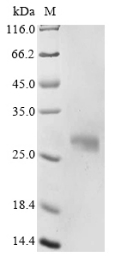Amino acids 21-189 form the expressed segment for recombinant Mouse Apod. This Apod protein is expected to have a theoretical molecular weight of 26.9 kDa. This Apod protein is produced using e.coli expression system. The Apod gene fragment has been modified by fusing the N-terminal 10xHis tag and C-terminal Myc tag, providing convenience in detecting and purifying the recombinant Apod protein during the following stages.
The mouse Apolipoprotein D (ApoD) is a glycoprotein primarily associated with lipoprotein particles in the bloodstream. It is a member of the lipocalin family and is involved in lipid metabolism and transport. ApoD plays a role in protecting cells from oxidative stress, neuroprotection, and modulation of inflammation. It has been linked to various physiological processes, including aging, neurodegenerative disorders, and cancer. In research, ApoD is studied to understand its functions in lipid homeostasis, and neuroprotection, and its potential implications in age-related diseases. Investigating ApoD's diverse roles contributes to our knowledge of lipid biology and its relevance to human health.






